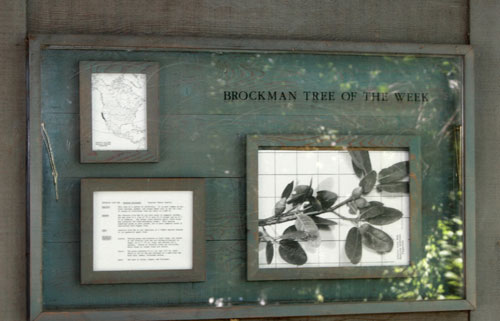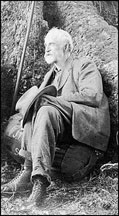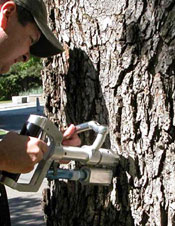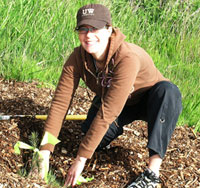 |
|||||||||
| Forest Resources Home | News | Make a Gift | UW Alumni | |||||||||
|
April 2010 | Return to issue home
Did You Know…? SFR Major Contributor to UW's 'Tree Campus USA' Designation
Forest Resources faculty, staff, students and alumni have all played an important part over the years in the UW’s recent designation as a "Tree Campus USA." The title was conferred last year by the Arbor Day Foundation in recognition of the UW’s dedication to campus forestry management and environmental stewardship. The UW is the first college in Washington to make the list, and that’s no surprise. Trees on the UW campus have always been considered one of its most valuable assets; the dream of a campus landscape that prominently featured trees, and even an arboretum, was integral to plans for the UW’s new campus when it opened in the fall of 1895. In fact, on opening day, the campus was designated "Grounds and Arboretum."
Edmond Meany, the legendary history professor and forestry lecturer who taught at the UW from 1897 to 1932 was responsible for the first campus tree plantings. Meany established a seed exchange program with botanical gardens across the country and abroad, nurtured the seeds in his home garden, and transplanted the seedlings on campus. However by 1906, the UW had shifted its focus to buildings rather than campus grounds, and in 1909, the Olmsted Brothers plan for the Alaska-Yukon-Pacific Exposition resulted in the clearing of campus grounds to build paths, roads and buildings for the exposition. Casualties of development included many of Meany's early plantings; but, according to Jim Kerin, retired UW staff member who had compiled a list of the UW’s historic and commemorative trees, a giant sequoia at the southeast corner of Smith Hall survives and is known as the Meany sequoia. Hugo Winkenwerder, College of Forestry dean from 1912-1945, worked with Meany on a proposal to locate an arboretum at the southern end of campus. Lack of funds prevented this development but Winkenwerder was able to convince then-UW-President Henry Suzzallo of the importance of an arboretum. A number of sites were considered and, finally, with a grant from the Seattle Garden Club, Winkenwerder hired the Olmstead Brothers firm to design the current arboretum in Washington Park. In 1935 the UW and the City of Seattle signed an agreement establishing the Washington Park Arboretum, now part of the UW Botanic Gardens. For a web exhibit prepared for the Arboretum’s 75th anniversary, see "Looking Back: A History of the Washington Park Arboretum." From these early connections with trees on the UW campus, to the establishment of the Washington Park Arboretum, to more recent involvement in the UW Landscape Advisory Committee, the Brockman Memorial Tree Tour, the office of campus arborist and the UW’s current tree mapping and pest management projects, SFR has provided input and service to insure the health and beauty of the campus grounds. The UW Landscape Advisory Committee, established in 1970, provides advice on, among other things, maintaining a list of satisfactory and desired plantings, and proposed modifications to campus open space and landscaping. Forest Resources faculty who have served on the committee include Emeritus Professor Dale Cole, ’55, ’63; former faculty member James Clark; and currently, Professors Bob Edmonds, ’68, ‘ 71 and Darlene Zabowski, ’81, ’83, ’88. Cole was the committee’s chair in 1999, when it undertook a major study of replacing the UW’s aging trees. A treasured space, the Quad and its Yoshino cherry trees, was part of the study. See Columns article “Blooms in Doom: As the Quad Cherries Age and Die, the UW Faces the Challenge of Preserving a 'Magic' Space.” The Brockman Memorial Tree Tour, a popular campus feature, is dedicated to the memory of the late Emeritus Professor C. Frank Brockman, who was on the Forest Resources faculty from 1946 until his retirement in 1967. In 1980 he produced the original UW tree tour booklet, edited by Louise Hastie, as an issue of the publication University Report. The eight-page publication, which included photos and scientific information, as well as the history of significant specimens, featured 81 campus trees and had to be reprinted several times by popular demand. In 1995, the tour was updated as part of a public artwork—visual artists Suzanne Hellmuth and Jock Reynolds designed two bus shelters and the Medicinal Herb Garden’s volunteer center on Stevens Way, deliberately creating openings in the shelters that “frame” nearby trees. Arthur Lee Jacobson, local plant expert, rewrote the tour booklet using Brockman’s original photos, and the Campus Arts Office developed a tree tour website. SFR Emeritus Professor Dale Cole, ’55, ’63, and the late Professor Emeritus Stan Gessel assisted with the editing. Over the years, trees in the tour have been removed for a variety of reasons, including safety and construction needs, and the tour is once again in need of updating. SFR undergraduate Carly Thornburg has been hard at work this year updating the tour website for her ESRM capstone project; she plans to add color photographs and seasonal information. The UW Campus Arborist position was initially held by the SFR staff arborist associated with the Washington Park Arboretum. From 2005-'07 Deborah Brown, ’07, master’s student in urban forestry served as arborist and was responsible for developing a tree valuation program associated with new construction on campus. Although, generally, the UW Grounds Department only removes trees if there is no other viable, safe alternative, occasionally trees are removed to accommodate construction projects. It was one such project involving a water oak near Balmer Hall that demonstrated the need for an objective way to evaluate campus trees. Brown and UW Landscape Architect Kristine Kenney worked on an evaluation system using a standard developed by the Council for Tree and Landscape Appraisers as a guide; see University Week story, "Campus trees: Extraordinary, exemplary or merely significant?"
UW Facilities Services Integrated Pest Management Program is another campus program that has benefited from SFR expertise, including that of Emeritus Professor of Forest Entomology, Bob Gara. SFR graduate students hold the position of Integrated Pest Management coordinator for the campus. Over the years these students have included David Mausel, ’02, and Michael Andreu, ’05, and currently Jessica Farmer, a joint master’s student in environmental horticulture and urban forestry and the Evans School. Both Mausel and Andreu were on campus when managing the threat of Dutch Elm Disease became a priority. In 2004 Andreu inoculated campus trees against the disease and worked on a pilot project to develop a geospatial database of the UW’s trees to assist in monitoring tree health. An effective tool not only for maintaining healthy tree populations and projecting needs for new plantings, a database could also educate students and the public about the value of the UW’s diverse urban forest. Two pilot studies completed by SFR undergraduates included that by Dawn Maurer, ’03, who mapped the trees in the grove north of Anderson Hall, and Ian Bishop, ’04 and Masako Hirata, ’06, who mapped the cherry trees throughout campus. The projects used Geographic Position Systems and lasers to locate the trees and the computer software Geographic Information Systems (GIS) to link maps to a database of information about the trees. Facilities Services, with assistance from students in the UW’s Department of Geography, has nearly completed the GIS-based inventory of campus trees. The comprehensive inventory has so far mapped more than 9,500 out of an estimated 11,000 trees. Each tree has received a uniquely numbered aluminum tag, and a variety of attributes are being collected for each tree. The database will soon be available to the public as an interactive web feature.
SFR has contributed in many other ways to the public education component of UW’s "Tree Campus" designation, including the many outreach and public education programs sponsored by UW Botanic Gardens. And, for nearly 10 years, beginning in 1996, Forest Resources and its alumni association sponsored an Arbor Day Fair on the UW campus, attracting 2,000 kindergarten through third grade children to a day of interactive displays. In recent years, SFR’s Arbor Day focus has been on developing service activities such as the Union Bay Natural Area’s Centennial Grove, planted in 2007 as a gift from alumni in recognition of the SFR’s history of academic excellence, research and leadership in sustainable natural resource management. References consulted include: * Photo courtesy UW Special Collections April 2010 | Return to issue home | |||||||||
|
|||||||||



